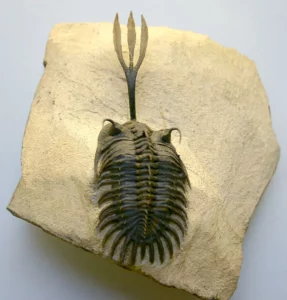Trilobites are extinct marine arthropods that are divided into three lobes; head, body, and thorax with jointed legs. Let us see some of its types below.
- Proetida
- Redlichiida
- Corynexochida
- Harpetida
- Agnostida
- Asaphida
- Odontopleurida
- Lichida
- Phacopida
- Ptychopardiia
Types of Trilobite
1. Proetida
Proetida are small trilobites made up of an exoskeleton with small pits called tubercles. The cephalon region contains large and convex eyes and a narrow long hypostome with genal spines. The thorax region is made up of 7 to 8 segments that are narrow and blunt.
2. Redlichiida
The species, Redlichiida are primitive trilobites with numerous thoracic segments that have spinose tips. The cephalon region is well-segmented, large, and semicircular with large eyes that are subdivided. The thorax region is divided into prothorax and opisthothorax.
3. Corynexochida
The cephalon of Corynexochida is usually convex, and elongated, and contains opisthoparian sutures. It also contains large eyes. Some species of Corynexochida have glabellae that are smooth and the other species have glabellar furrows that have a splayed arrangement. There are about 7 to 8 segments in the thorax region with spinose pleural tips.
4. Harpetida
Harpetida consists of a large semicircular brim around the cephalon region that is perforated with small pores. The brim is used to filter the food particles. It usually stretches backwards on either side of the head region and has a suture on the outside. The eyes are reduced into small tubercules with strong ridges that stretch to the central region of the cephalon.
5. Agnostida
Agnostida are small trilobites that are only a few mm long. The cephalon and the pygidium are similar in size with a clam-shell-like appearance. Most of the species lacked eyes, had ribbon-like wings and contained three thoracic segments that had special appendages used for swimming.

6. Asaphida
In Asaphida order, the head (Cephalon) and the pygidium (tail) are similar in size and have a prominent ventral suture. The head is usually flat with furrows that are faint and the thoracic region consists of about 5-12 segments. A wide rim surrounds the cephalon region with large eyes.
The species of asaphida existed in the middle Cambrian time and became extinct during the Silurian era. It consists of six superfamilies:
- Anomocaroidea
- Asaphoidea
- Cyclopygoidea
- Dikelocephaloidea
- Remopleuridoidea
- Trinucleioidea
7. Odontopleurida
The species of Odontopleurida have a convex and bar-shaped cephalon and a lobed knob-shaped glabella which extends to the anterior region. Most of them have long spines that are derived from the exoskeleton and sometimes they form granular ornamentation. The thoracic region is divided into 8 to 13 segments.
The pygidium is very small and it also has long spines that are used for protection purpose and it also prevented the trilobite from sinking. These species were found between the Ordovician to Devonian eras.
8. Lichida
The Lichida species existed between the Furogian and Devonian eras. The body consists of a lot of spines that extend from the cephalon region to the pygidium region. Usually, the exoskeleton is grainy in texture and has wart tubercles. There are about 8-13 segments in the thoracic area.
Lichida order is divided into two families; Lchidae and Lichakephalidae.
9. Phacopida
Phacopida (means lens-face) lived during the late Cambrian to late Devonian era. The head (cephalon) is usually short or absent. Eyes are schizochoral or holochroal with rostral plates. There are 4 pairs of glabellar furrows in the head region.
8-19 segments are present in the thoracic region that is clearly furrowed and broad. The pygidium is either lobed or spiny with smooth margins. It consists of three suborders:
- Calymenina
- Phacopina
- Cheirurina
10. Ptychopariida
The Ptychopariida species occurred between the lower Cambrian and Upper Ordovician era. These are large heterogeneous order that has primitive origins and specialized offshoots. The cephalon consists of opisthoparian facial structures that gently taper into simple glabella that are broad and round with furrows. It consists of about 8 thoracic segments and the pygidium is small and broad.
Examples of Trilobites
There are many species of trilobites, let us see a few examples of them:
- Asaphiscus wheeleri
- Bailiella levyi
- Boedaspis ensifer
- Metacanthina
- Redlichia noetlingi
- Redlichia takooensis
- Paradoxides gracilis
- Paradoxides davidis
- Redlichia chinensis
- Terataspis grandis
Conclusion
Trilobites are extinct animals that belong to the arthropod family. They are divided into Cephalon (head), thorax, and pygidium (tail) and have appendages. They mostly existed between the Pre-Cambrian to Permian eras.
Also Read:
- Enzymes and photosynthesis
- Rhizome examples
- Dispersive dna replication
- Bees examples
- Do red blood cells have a cell wall
- Mitosis stages
- Does meiosis occur in chromosomes
- Are algae autotrophs
- Are globular proteins soluble
- Commensal bacteria examples

Hi….I am Shravanthi Vikram, I have completed my master’s in Bioinformatics and have 10 years of teaching experience in Biology.
Let’s connect through LinkedIn-